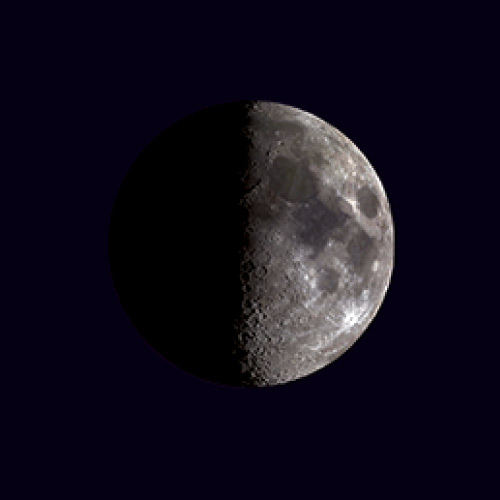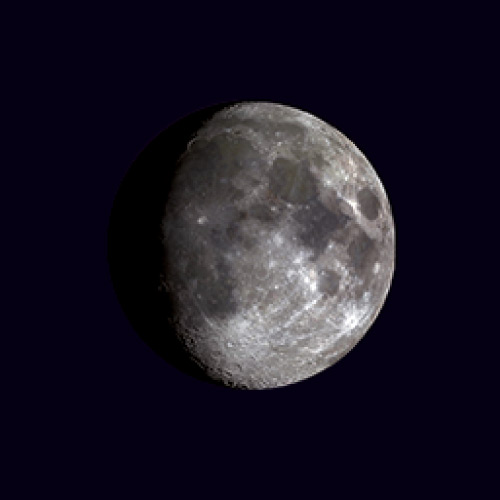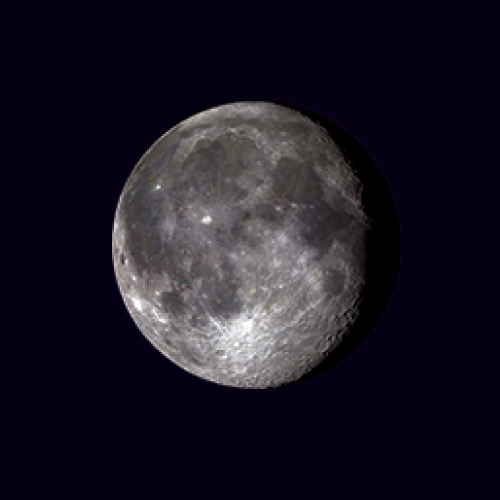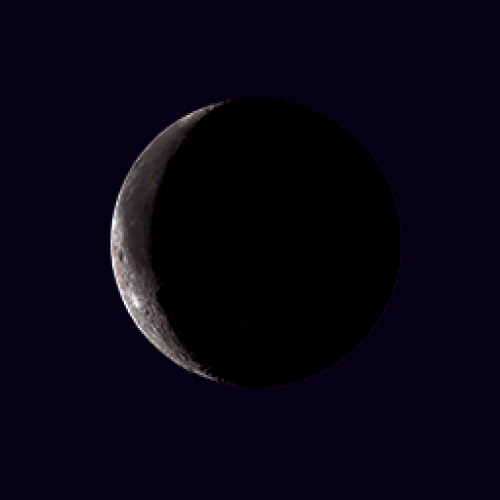Recall that the Moon orbits Earth while Earth is orbiting the Sun. From Section 1.2.2, you already know that the Moon’s orbit around Earth is so small compared to Earth’s orbit around the Sun that sunlight seems to arrive at both Earth and the Moon from the same direction (Figure 2.23). As we will see, this fact leads directly to the phases of the Moon.
Figure 2.23 – The Sun is so much farther away from us than the Moon that sunlight appears to come at both Earth and the Moon from the same direction. (The sizes of Earth and the Moon are exaggerated about 15 times compared to the Moon’s orbit in this diagram.)
The Sun is so much farther away from us than the Moon that sunlight appears to arrive at both Earth and the Moon from the same direction. (The sizes of Earth and the Moon are exaggerated about 15 times compared to the Moon’s orbit in this diagram.) You can also click to play a video showing why we see sunlight coming from the same direction.
Understanding Phases
Figure 2.24 In this demonstration, your head represents Earth and the ball represents the Moon as it orbits Earth. The half of the ball (Moon) facing the Sun is always illuminated while the other half is dark, but from your perspective in the middle, you see the ball (Moon) go through the phases shown in the photos. The labels indicate the approximate times of day at which each phase rises, reaches its highest point in the sky, and sets (exact times vary with location, time of year, and orbital details). Credit: The Cosmic Perspective.
You can understand the lunar phases by doing the simple demonstration illustrated in Figure 2.24 (and described in its associated video). Take a ball outside on a sunny day. (If it’s dark or cloudy, you can use a flashlight instead of the Sun; put the flashlight on a table a few meters away and shine it toward you.) Hold the ball at arm’s length to represent the Moon while your head represents Earth. Slowly spin around so that the ball goes around you the way the Moon orbits Earth. As you turn, you’ll see the ball go through phases just like the Moon.
Activity
Moon Phases Demonstration
Before you continue, do the Moon phase demonstration as described above and in the video. Do you notice the way the ball you are holding changes its phase as it moves around you?
Teacher Notes. It is a good idea to do the Moon phase demo in pairs, so students can discuss and be sure they understand what they are seeing. Note: Students will see the phases no matter which direction they turn. However, to see the phases progress the way we see them in the Northern Hemisphere, students should rotate counterclockwise, because that is the direction of the Moon’s orbit as viewed from above the North Pole. Students in the Southern Hemisphere should rotate clockwise (rather than counterclockwise), because that is the direction of the Moon’s orbit as viewed from above the South Pole.)
If you think about what’s happening in your demo, you’ll realize that the phases of the ball result from just two basic facts:
- Half the ball always faces the Sun (or flashlight) and therefore is bright, while the other half faces away from the Sun and is dark.
- As you look at the ball at different positions in its “orbit” around your head, you see different combinations of its bright and dark faces.
For example, when you hold the ball directly opposite the Sun, you see only the bright portion of the ball, which represents the “full” phase. When you hold the ball at its “first-quarter” position, half the face you see is dark and the other half is bright.
We see lunar phases for the same reason. Half the Moon is always illuminated by the Sun (the day side) while the other half (the night side) is facing away from the Sun. However, as we look from Earth, we see varying amounts of the day and night sides, depending on the Moon’s position in its orbit. The photographs in Figure 2.24 show how the phases look. (The new moon photo shows blue sky, because a new moon is nearly in line with the Sun and therefore hidden from view in the bright daytime sky.)
Key Concepts: Phases of the Moon
Many people guess that the Moon’s phases are caused by Earth’s shadow falling on its surface, but this is not the case. As you should now understand, the Moon’s phases are caused by the fact that we see different portions of its daylight and night sides at different times as it orbits around Earth. The only time Earth’s shadow falls on the Moon is during the relatively rare event of a lunar eclipse.
Teacher Notes: The video should be a useful summary, but in general it is much more effective if students have already done the Moon phase demonstration above.
Lunar Phases
This short video summarizes why we see phases of the Moon.
Names of the Phases
Figure 2.24 also shows the names we give to the different phases of the Moon. It will be easy to remember these names if you think about what the mean. Let’s start with new and full moons:
- New moon is the name we use for the phase when we don’t see the Moon at all; the name comes from ancient myths holding that the Moon disappeared from view because it was being reborn at this time.
- Full moon gets its name from the fact that we see the full face of the Moon in our sky.
Next consider the “quarter” moons. You’ll see that these are the times when we see half the Moon’s face. It might seem strange that what looks like a “half moon” is actually called a quarter moon, but here is the reason:
- First quarter moon gets its name from the fact that we see it when the Moon is one-quarter of the way through its cycle from new to full and back again.
- Third quarter moon gets its name from the fact that we see it when the Moon is three-quarters of the way through its cycle from new to full and back again.
For the in-between phases, the complete names have two parts:
- Part 1: Waxing or Waning. All of the phases as we go from new moon to full moon are called waxing, which means “increasing.” The phases going from full moon back to new moon are waning, which means “decreasing.”
- Part 2: Shape. A crescent is the shape when we see a relatively thin sliver of the Moon’s face illuminated. The opposite of a crescent, when the Moon is mostly but not-quite-all-the-way full is called gibbous (pronounced with a hard g as in “gift”). The word “gibbous” means “hump” or “hunchbacked,” and you’ll notice that the gibbous moon looks rather like a hump or hunchback.
We therefore get the following names:
- A waxing crescent moon is the crescent shape we see between new and first-quarter moon.
- A waning crescent moon is the crescent shape we see between third-quarter and new moon.
- A waxing gibbous moon is the gibbous shape we see between first-quarter and full moon.
- A waning gibbous moon is the gibbous shape we see between full and third-quarter moon.
Journal Entry
Labeling Your Moon Phases
Return to the pages on which you’ve been recording Moon phases in a table, in which the first column has the date, the second column the time of your Moon observation, and the third column has your sketches of the Moon phase. Now, under the date in the first column, add the name of the phase you were viewing that day. Be sure you understand how your own observations correspond to what you’ve learned about the phases and their names.
Quiz
Note: As always, after you finish the quiz, be sure you read the feedback that explains the correct answers, to make sure you understand the reasons for these answers.
The View From the Moon
Teacher Notes. This subsection is optional, but it provides a good way to solidify student understanding of phases.
A good way to solidify your understanding of the lunar phases is to imagine that you live on the Moon and think about how Earth would appear. For example, what would you see if you looked at Earth when people on Earth saw a new moon?
By remembering that a new moon occurs when the Moon is between the Sun and Earth, you’ll realize that from the Moon you’d be looking at Earth’s daytime side and hence would see a full earth. Similarly, at full moon you would be facing the night side of Earth and would see a “new earth”.
In general, you’d always see Earth in a phase opposite the phase of the Moon seen by people on Earth at the same time. For example, Figure 2.25 shows a gibbous Earth being seen from the Moon, which means that on Earth we were seeing a crescent moon at this time.








